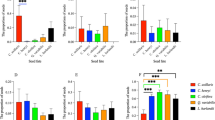Summary
Knowledge of the basis upon which granivores select seeds is crucial to the understanding of granivory. In this study the preferences of three rodent granivores among seeds of 11 plants from the semi-arid Karoo of South Africa were estimated, and related to the physical and chemical attributes of the seeds. Seed weights and calorific, moisture, protein, polyphenol, ash, lipid and silica contents were estimated and cell contents, soluble ash and soluble carbohydrate contents were derived from these values. These attributes were determined for both the intact seeds and the portion of the seed that is ingested by the mice. The efficiency with which mice ingested the seeds (in terms of time and mass) was recorded. All three mouse species ranked the seeds similarly, and the two species for which handling efficiency was measured did not differ in this regard. Preference hierachies were highly correlated with the rate of energy intake, as predicted by optimal foraging theory. There was no correlation between rodent preferences and the gross energy content of the seeds, emphasising the importance of measuring relevant parameters. The energy yield of the seeds calculated here, in conjunction with rodent population energy requirements and dietary data, may be used to estimate potential granivore impact on the seed production of the plant community.
Similar content being viewed by others
References
Blytt HJ, Guscar TK, Butler LG (1988) Antinutritional effects and ecological significnace of dietary condensed tannins may not be due to binding and inhibiting digestive enzymes. J Chem Ecol 14:1455–1465
Brown JH, Davidson DW, Munger JC, Inouye RS (1986) Experimental community ecology: the desert granivore system. In: Diamond J, Case TJ (eds) Community ecology. Harper and Row, New York, pp 41–61
Daiber KH (1975) Enzyme inhibition by polyphenols of sorghum grain and malt. J Sci Food Agric 26:1399–1411
Dixon WJ (1981) BMDP Statistical software 1981. Univ. California Press, pp 1–726
Everett RL, Meeuwig RL, Stevens R (1978) Deer mouse preference for seed of commonly planted species, indigenous weed seed, and sacrifice foods. J Range Managm 31:70–73
Frank CL (1988) The relationship of water content, seed selection, and the water requirements of a heteromyid rodent. Physiol Zool 61:527–534
Gibbs Russell GE, Welman WG, Retief E, Immelman KL, Germishuizen G, Pienaar BJ, Van Wyk M, Nicholas A (1987) Lists of species of southern African plants. Part 2, second edition. Mem Bot Surv S Afr 56:1–270
Greig-Smith PW, Wilson MF (1985) Influences of seed size, nutrient composition and phenolic content on preferences of bull-finches feeding on ash trees. Oikos 44:47–54
Harris LE (1970) Nutrition research techniques for domestic and wild animals. Vol 1. Utah State Univ., Logan
Henderson CB, Petersen KE, Redak RA (1988) Spatial and temporal patterns in the seed bank and vegetation of a desert grassland community. Ecology 76:717–728
Hulbert AJ, Macmillen RE (1988) The influence of ambient temperature, seed composition and body size on water balance and seed selection in coexising heteromyid rodents. Oecologia 75:521–526
Jenkins SH (1988) Comments on relationships between native seed preferences of shrub-steppe granivores and seed nutritional characteristics. Oecologia 75:481–482
Jerumanis J (1972) Über die Veränderung der Polyphenole im Verlauf des Malzens und Maischens. Brauwissenschaft 25:313–322
Kaufman LW, Collier G (1981) The economics of seed handling. Am Nat 118:46–60
Kelrick MA, Macmahon JA (1985) Nutritional and phyiscal attributes of seed of some common sagebrush-steppe plants: some implicaitons for ecological theory and management. J Range Managm 38:65–69
Kelrick MI, MacMahon JA, Parmenter RR, Sisson DV (1986) Native seed preferences of shrub steppe rodents, birds and ants: the relationship of seed attributes and seed use. Oecologia 68:327–337
Kerley GIH (1989) Diet of small mammals from the Karoo, South Africa. S Afr J Wildl Res 19:67–72
Marks DL, Swain A, Goldstein S, Richard A, Leighton M (1988) Chemical correlates of rhesus monkey food choice: the influence of hydrolyzable tannins. J Chem Ecol 14:213–235
Nelson JF, Chew RM (1977) Factors affecting seed reserves in the soil of a Mojave desert ecosystem, Rock Valley, Nye County, Nevada. Am Midl Nat 97:300–320
Paramenter RR, MacMahon JA, Vander Wall SB (1984) The measurement of granivory by desert rodents, birds and ants: a comparison of an energetics approach and a seed dish technique. J Arid Environ 7:75–92
Price MV (1983) Laboratory studies of seed size and seed species selection by heteromyid rodents. Oecologia 60:259–263
Price MV, Heinz KM (1984) Effects of body size, seed density, and soil characteristics on rates of seed harvest by heteromyid rodents. Oecologia 61:420–425
Price MV, Reichman OJ (1987) Distribution of seeds in Sonoran desert soils: implications for heteromyid rodent foraging. Ecology 68:1797–1811
Pulliam HR (1974) On the theory of optimal diets. Am Nat 108:59–74
Pulliam HR, Brand MR (1975) The production and utilization of seeds in plains grassland of southwestern Arizona. Ecology 65:1158–1166
Reichman OJ (1975) Relation of desert rodent diets to available resources. J Mammal 56:731–751
Reichman OJ (1976) Relationships between dimensions, weights, volumes, and colories of some Sonoran Desert seeds. South-western Natl 20:573–575
Smigel BW, Rosenzweig ML (1974) Seed selection in Dipodomys merriami and Perognathus penicillatus. Ecology 55:329–339
Smith CC, Folmer D (1972) Food preferences of squirrels. Ecology 53:82–91
Zar JH (1984) Biostatistical analysis, second edition. Prentice-Hall Inc., Englewood Cliffs
Author information
Authors and Affiliations
Rights and permissions
About this article
Cite this article
Kerley, G.I.H., Erasmus, T. What do mice select for in seeds?. Oecologia 86, 261–267 (1991). https://doi.org/10.1007/BF00317539
Received:
Accepted:
Issue Date:
DOI: https://doi.org/10.1007/BF00317539




